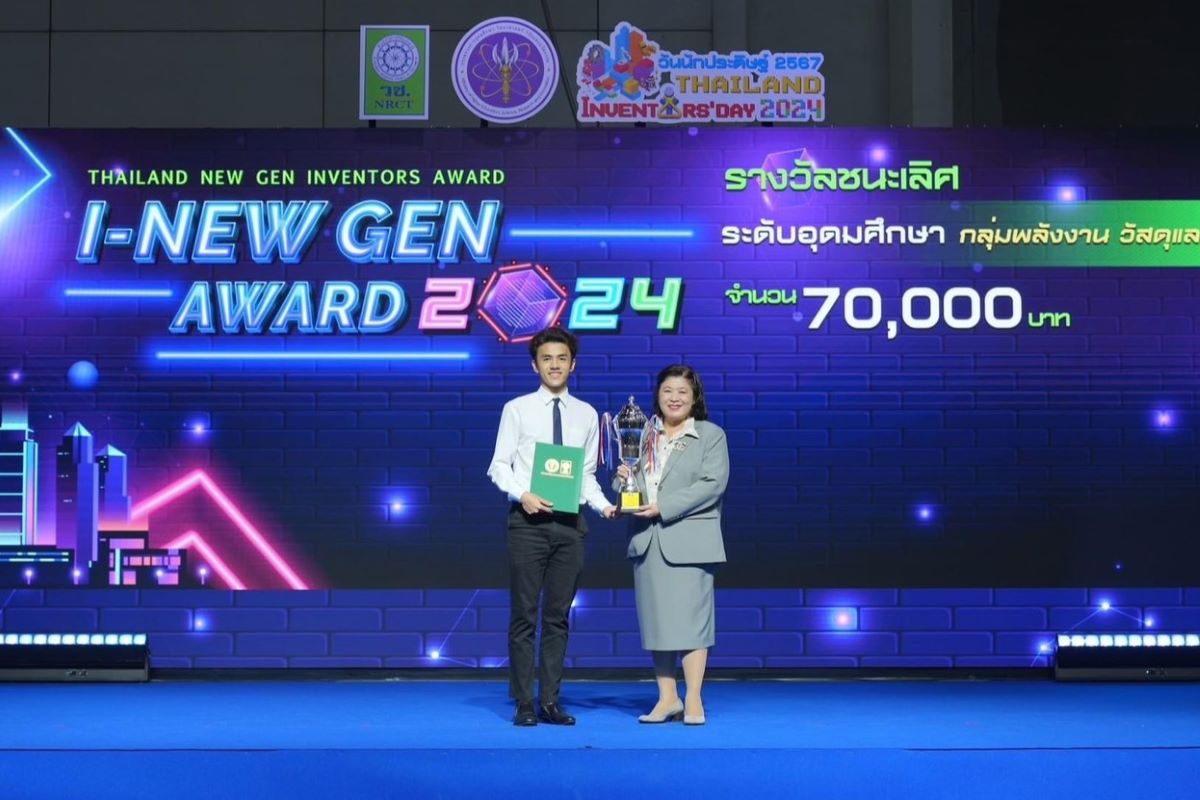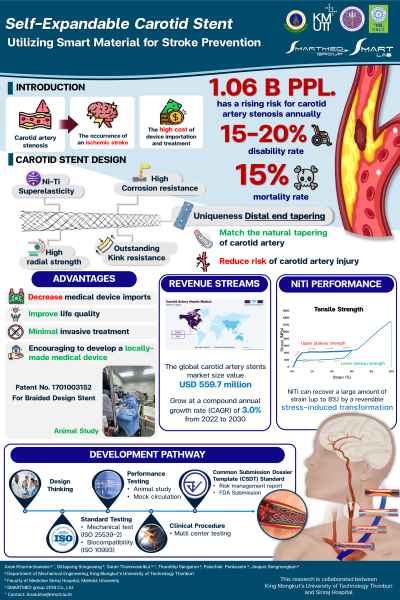


“Stents supporting the carotid arteries from self-expanding smart materials for stroke prevention,” the work of 3 students from the Faculty of Engineering and School of Architecture and Design, King Mongkut’s University of Technology Thonburi (KMUTT), by There is Assoc.Prof.Dr. ANAK KHANTACHAWANA Department of Mechanical Engineering Faculty of Engineering and the head of KMUTT’s SMART LAB is an advisor. Received first place award in the Energy, Materials and Biological Chemistry group. From the stage of the youth invention competition Thailand New Gen Inventors Award 2024: I-New Gen Award 2024 at the Inventors’ Day 2024 organized by the National Research Council of Thailand (NRCT), Ministry of Higher Education, Science, Research and Innovation (MHESI) on In the beginning of 2024, all three of them, in addition to being seniors and juniors from different faculties, have come to work together. They are also seniors and juniors from Princess Chulabhorn Science High School Pathumthani and have worked together before since high school. Because they are all science students who like to do research. and send it to compete in various stages This has led to collaboration again at the university level. And from the beginning of this work, there was a path that laid the foundation for the three students to gain knowledge and experience in becoming “Researchers in materials science and bioengineering” to work in medicine in the future

As for the development of the “self-expanding smart material carotid artery stent for stroke prevention,” the team leader said that the carotid artery, which is the main artery on both the left and right sides of the neck, It is a blood vessel that branches directly from the large artery in the chest. Serves to nourish the brain If this blood vessel becomes narrowed or a blood clot escapes from the blood vessel into the peripheral artery, it will cause blood to flow to the brain poorly or become blocked. As a result, there is a lack of blood flow to the brain, which results in ischemic stroke. But at present, most treatment equipment is imported from abroad and is expensive. It is a barrier to accessing treatment. In addition, we received questions from specialist doctors. Diagnostic radiology field Department of Radiology Faculty of Medicine Siriraj Hospital Mahidol University said The physique of Asian people is different from European people. Using equipment made in foreign countries may not be suitable for the body of Thai people. Therefore invited friends to do it together by using the version 1 prototype developed by SMART LAB seniors to develop a new format and design it to be different from the original format that was being used. and to be able to use it most efficiently We started developing version 2 at the end of 2023 and received the first prize from the National Research Council of Thailand (NRCT) last February.
One student on the team said: “Because human blood vessels will gradually shrink if we apply the same force throughout the entire line in the same radius. The cross-sectional area of the coil throughout the coil is the same. This means that smaller channels or blood vessels will receive a greater force and may cause damage to the blood vessel. This must be calculated. Therefore, we designed version 2 that has a tapered or sloped shape, which is a formula that we developed ourselves. We have studied and researched the research literature on the anatomy of the carotid arteries. Until there was an idea that designing the weave steps in this way would work better and reduce injuries. Once we have the prototype, we will need to calculate how much labor we will need when inserting it into a blood vessel. Because this device will stay in the blood vessel in that area for the rest of your life. For example, if you want the coil to work at a temperature of 37 degrees in the body. How much force must be given? Controlling this force depends on two factors: the design of the equipment process and whether the wire is used with a high or low force.”

Assoc.Prof.Dr. ANAK KHANTACHAWANA Department of Mechanical Engineering Faculty of Engineering And the head of SMART LAB said that we are a laboratory that develops medical devices, emphasizing the use of smart materials in the treatment process with minimal injuries. We therefore use a catheter-based treatment method. which can bring the treatment equipment to every point of the body where it is needed through the operating room Has been interested in this matter since 2015, starting with research and signing memorandum of cooperation with various medical faculties such as Siriraj Hospital, Ramathibodi Hospital and medical faculties of major universities. Starting with the innovation and design and development of catheters for heart disease. Stroke and continued to expand until establishing a startup called Smartmate Group 2019 Co., Ltd. Currently preparing to build a factory.
As for the coil work version 2, the students are still at the Tier 3 level (Tier 3), which is the level of designing, making prototypes, and testing (not yet used on living things). They must produce prototypes in large quantities to send. Tested in India It is a safety test as specified by the FDA with more than 15 items before being tested on living things, such as testing mechanical properties. irritation and test for biocompatibility, etc. Examples of test details include how much back pressure will there be at a temperature of 37 degrees? And if connected to a catheter, how much resistance will there be? or how much resistance there is to the curve in the blood vessel, as determined by the FDA. After this The student team will continue to develop their work. as planned In order for what is designed to be able to pass testing at the Tier 5 level (Tier 5), it must be produced in a real location. It has set a goal to use it in humans by the end of 2025.
Currently, there are quite a number of Thai people suffering from carotid stenosis, more than 100,000 people per year, and it is also found that the number of patients is increasing every year. Because the number of elderly people in Thailand tends to increase and the danger from this disease begins to occur to people who are getting younger and younger. because of food People with carotid stenosis have a death rate of 15% and another 15-20% of people with this disease will experience paralysis or paralysis.
“This piece of equipment. It has a global market value of more than 4,000 million baht because the equipment costs as much as 100,000 baht per piece. If Thailand can produce it within the country, the price will be lower on average to over 60,000 baht per piece. This will help Thai people have access to this equipment. Therefore, the purpose of developing this device It’s not just about having a size that fits the bodies of Thai and Asian people only. But they want Thai people to have access to more devices at a lower price. Increase the quality of life for Thai people and help reduce the cost of importing expensive medical equipment. Therefore, we have to design something different from what is available in foreign countries, that is, the steps and sizes are suitable for the Thai body. It is also a device that Thailand will be the only manufacturer in ASEAN,” Assoc.Prof.Dr. ANAK said.
